As anyone who comes by this spot with any type of regularity will already know, transportation issues - whether it be roads, cars, bikes, trains, etc - fascinate me. In part this is because I believe that our approaches to transportation have a significant impact on the lives we lead; and, in part, it's because I'm a person who lives in a rural area and must travel considerable distances both for work and personal activities.
To the latter end, automobile efficiency has a significant impact on my life, and I've often tried to select my cars accordingly. When the original Chevrolet Volt came out back in 2011 I spent some time trying to understand how to figure out whether it would be a good choice for me. This turned out to be more complicated than I thought it would be:
The Chevy Volt has a problem.
Confusion.
This past February I had the good fortune to attend the Chicago Auto Show with the inimitable Ted E. Dunphy. We go to the auto show every year or two, but this year I was particularly interested in seeing and having the opportunity to ride in the Chevy Volt. The ride was fun - around a short track inside McCormick Place, the cars running entirely on electricity.
What was more interesting - and perplexing - was trying to figure out what kind of mileage I would get with the car. Usually this is a relatively straight-forward thing, published clearly on the window sticker of each new car. But if the Volt were treated the same way, it's sticker would just say "it depends".
In a nutshell, because the car has an electric only range, how much gas a person would use would depend upon how far they drive - the more driving done outside the range of the electric motor, the less attractive the Volt becomes.
In that original post I compared the 2010 Volt to two of my own cars - a 2007 Mini Cooper S and a 2010 Honda Fit - as well as the Toyota Prius, which is probably its primary competitor. I also included the original Honda Insight, a car I have always been interested in, albeit one that is very different than the rest of the group.
For the original Volt it turned out to best all of the others in real-world mileage for people driving less than 25,000 miles per year, over which the two hybrids - the Prius and the Insight - caught up with it. Even then, though, the Volt was still competitive in terms of mileage.
Where it suffered, though, was overall cost of ownership:
But gasoline is not the only cost of owning a car. Most people buying a car will borrow, and that cost will always be a relevant factor. If one compares the same cars, including the monthly car payment assuming a five year loan with no down payment for each new car, and the blue book value and a two year loan for the Honda Insight, and my current car payment for the Mini, one gets a considerably different picture... Because of it's relatively high purchase price ($32,780 after government rebate), adding in the car payment ramps up the cost of Volt ownership considerably.
I found then that, ultimately, the cost of monthly payments completely reversed the situation, and the Volt moved from least to most expensive to operate. The price of entry was a more relevant component than the fuel costs.
Several important things have changed since 2011:
- The electric range of the Volt has increased considerably - from about 35 miles to 53 miles.
- The MPG rating of the gas generator - the mileage the car gets after it runs out of battery charge - is also much higher, rising from 37 mpg to 43 mpg.
- The original Volt required premium fuel, while the new one gets by with less expensive, regular unleaded.
- The price of the Volt has dropped. With the government rebate in place, the purchase price is now $26,495.00
So the question is, what kind of a difference do those changes make?
This time around I compared the 2016 Volt to the 2016 Prius and the 2016 Honda Fit. I also included my 2010 Fit as a comparator to evaluate against a fully paid-for, relatively efficient compact car as an option. Assumptions made were:
- An average fuel price of $2.183 per gallon, based upon the Midwest price on 5/2/16 from the US Energy Information Administration website.
- Mileage ratings of 34 mpg for the 2010 Fit (based upon my personal measurements), 37 for the 2016 Fit, 52 for the 2016 Prius, and 43 for the 2016 Volt.
- To account for the Volt's all electric range, the number of miles it traveled was reduced by that range, assuming overnight charging only (e.g. no opportunity for additional charging during the day). For example, a yearly travel amount of 10,000 miles was averaged out to 200 miles per week, or 40 miles per day over five days (a work week) for the other cars. The 40 miles per each day was decreased by the electric range of the Volt - 53 miles - to calculate the remaining average miles traveled per day, and that remaining mileage was calculated against the Volt gas generator mpg of 43 miles per gallon.
- The same price of $26,495.00 for the Volt and the Prius. This decision was made because there are so many option levels for the Prius that it's price ranges from about $24k up to well over $30k. This seemed simpler and more straightforward.
- The 2016 Honda Fit model selected was an EX with a handful of options based upon my personal preferences (The EX is the highest end Honda Fit that is available with a manual transmission) for a purchase price of $19041.00.
- Monthly payments were based upon a 5-year loan, with no down payment, a 6.25% sales tax (Illinois), and 3.26% interest, calculated on the car payment calculator on Cars.com.
With all of this done, what I found was this:
The Volt is still the hands-down winner in terms of fuel cost:

If you drive less than 10,000 miles per year, odds are good that you will pay virtually nothing for fuel over the course of that year, and the cost for folks at 15k/year is less than $100. Back in 2011 the Volt's advantage leveled off with the Prius's for people who traveled 25k or more miles per year. With the improvements in range and fuel efficiency the 2016 Volt maintains a considerable advantage in fuel economy all the way up to 30k per year. If you are a high mileage driver deciding between a Prius and a Volt, on average the Prius will use $1259.42 worth of gas per year, while the Volt comes in at $850.35.
As in 2011, things change when we add in the cost of purchase:
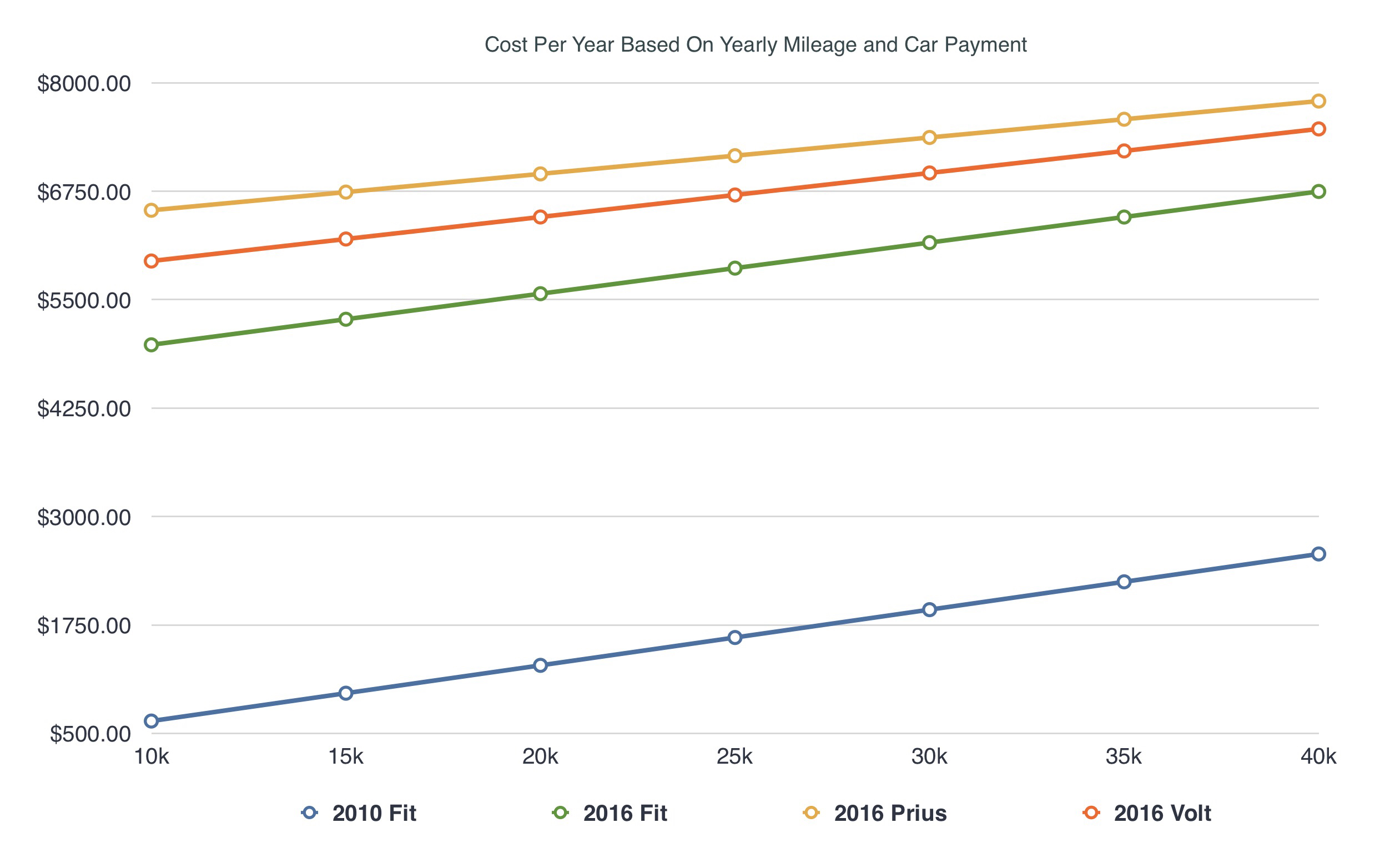
What we see here, unsurprisingly, is that your cheapest option is still to own your own economy car outright (the 2010 Fit), and that the amount of fuel savings of neither the Volt nor the Prius is sufficient to compensate for the difference made by buying a conventional economy car that is several thousand dollars cheaper. If you must buy a new car, and you are looking for the least expensive overall cost of ownership, something comparable to the Honda Fit is still your best option.
What is pleasantly surprising to learn, however, is that the improvements made for the 2016 Volt make it less expensive to own than a price-comparable 2016 Prius, even for very high-mileage drivers. If you must buy new, and you are comparing hybrid options, the Volt is your best bet. General Motors has come a long way down this road, and it's worth noting that this is only the second-generation of the Volt. Toyota is on it's fourth generation of Prius, and has been building them now for nearly 20 years (the first Prius came out in 1997).
Of course, one does not have to buy a price-comparable Prius. The Prius comes in at a lower base-price, and one could opt for that car, which costs $24,200.00, according to Toyota's website. But it turns out that the cheapest Prius comes out to mostly be comparable to the Volt:
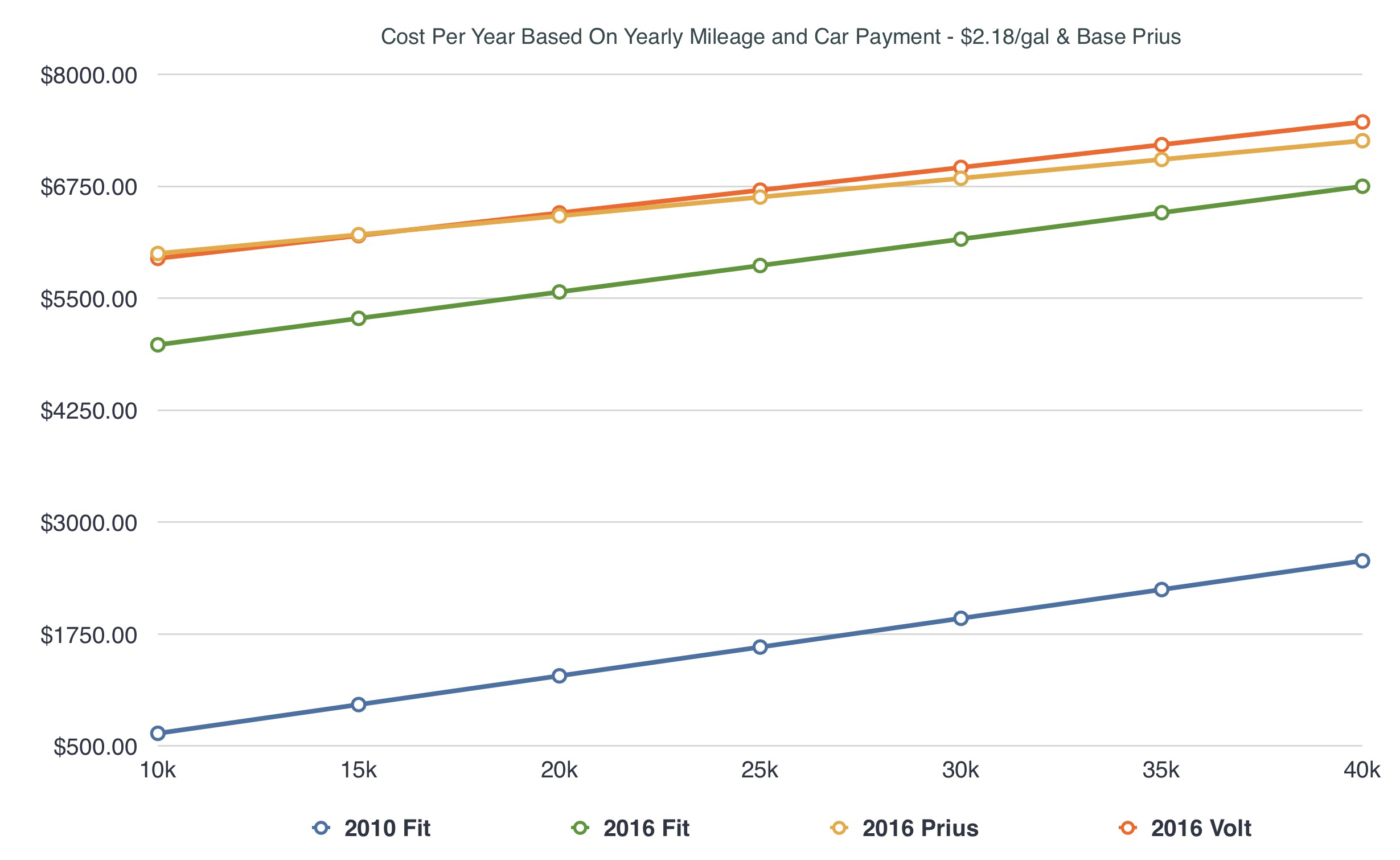
So - if you are selecting between the Volt and the Prius, you aren't really saving much in terms of overall cost of operation by opting for the base Prius to get in at a lower initial purchase price. Given Toyota's head start on this I'd still call this advantage Volt.
And Now for Some Speculation
I noted above that the fuel savings of neither the Volt nor the Prius were enough to make them less expensive than a conventional economy car like the Honda Fit. This is the case, in part, because gasoline is relatively inexpensive in the US at the moment. Out of curiosity I adjusted amounts to see what gas prices would need to be in order for that savings to make the difference.
The Volt takes the advantage here as well. It starts to become cost-comparable with the Fit for low mileage drivers at a gas cost of about $4.75 per gallon:
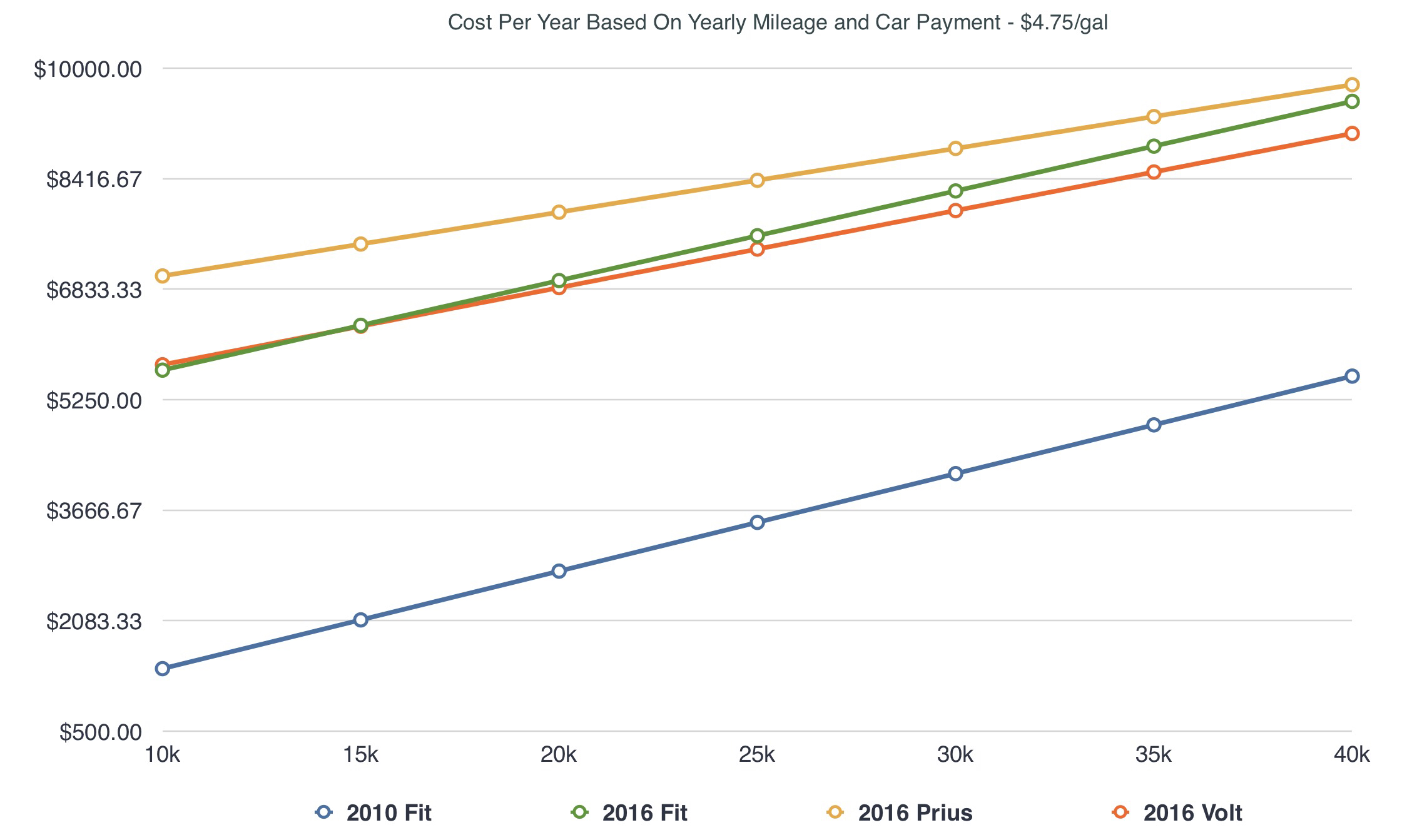
And it's comparable or better for all drivers if gas rises twenty-five cents to about $5.00 per gallon:
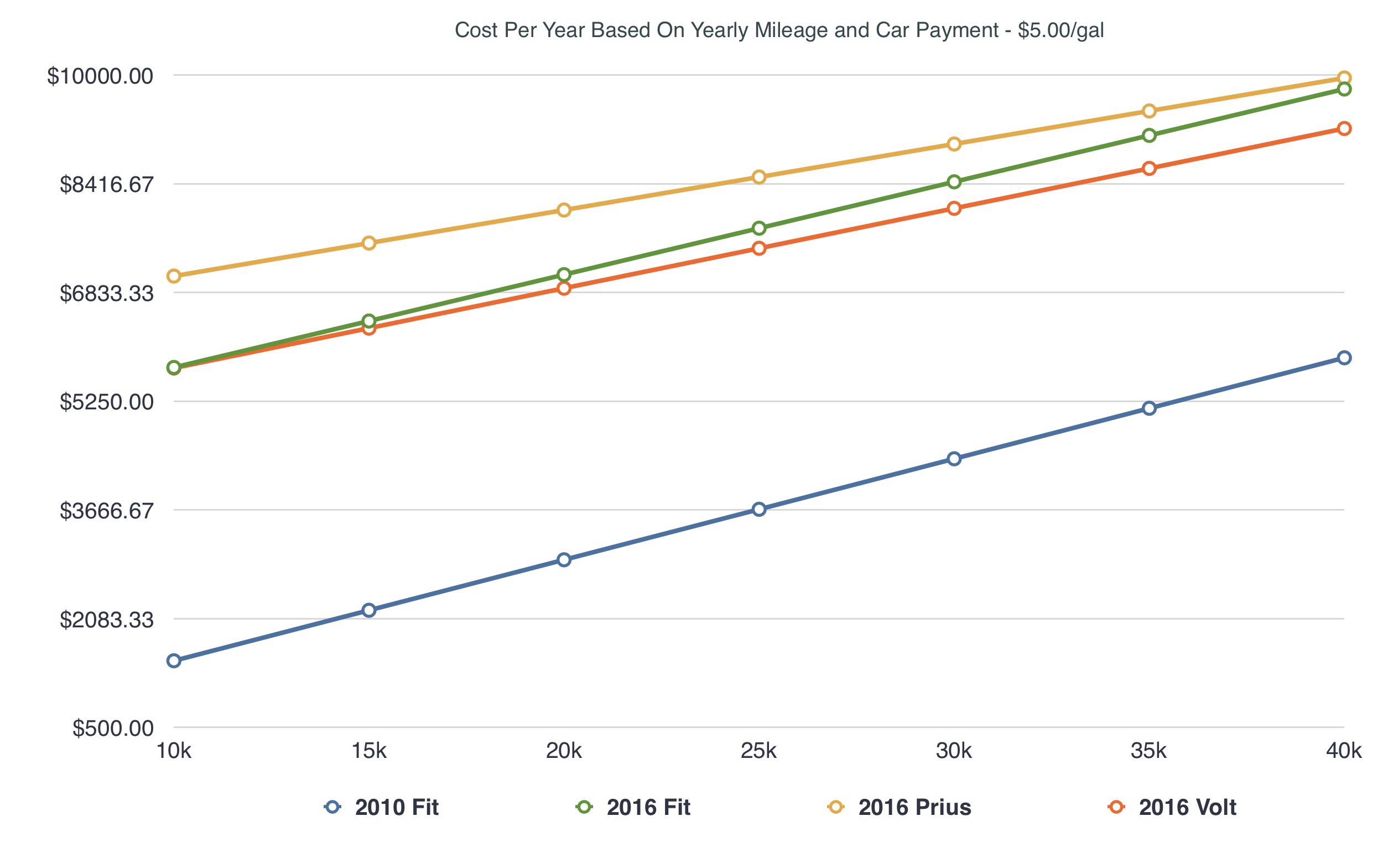
As can also be seen here, the Prius is still more expensive to own than the Fit, though it's getting closer to comparable for super-high mileage drivers. The Prius reaches a comparable level for those at 40k miles per year if prices rise to $5.75 per gallon, but at that price the Fit is still the better deal for anyone driving 35k or fewer miles per year:
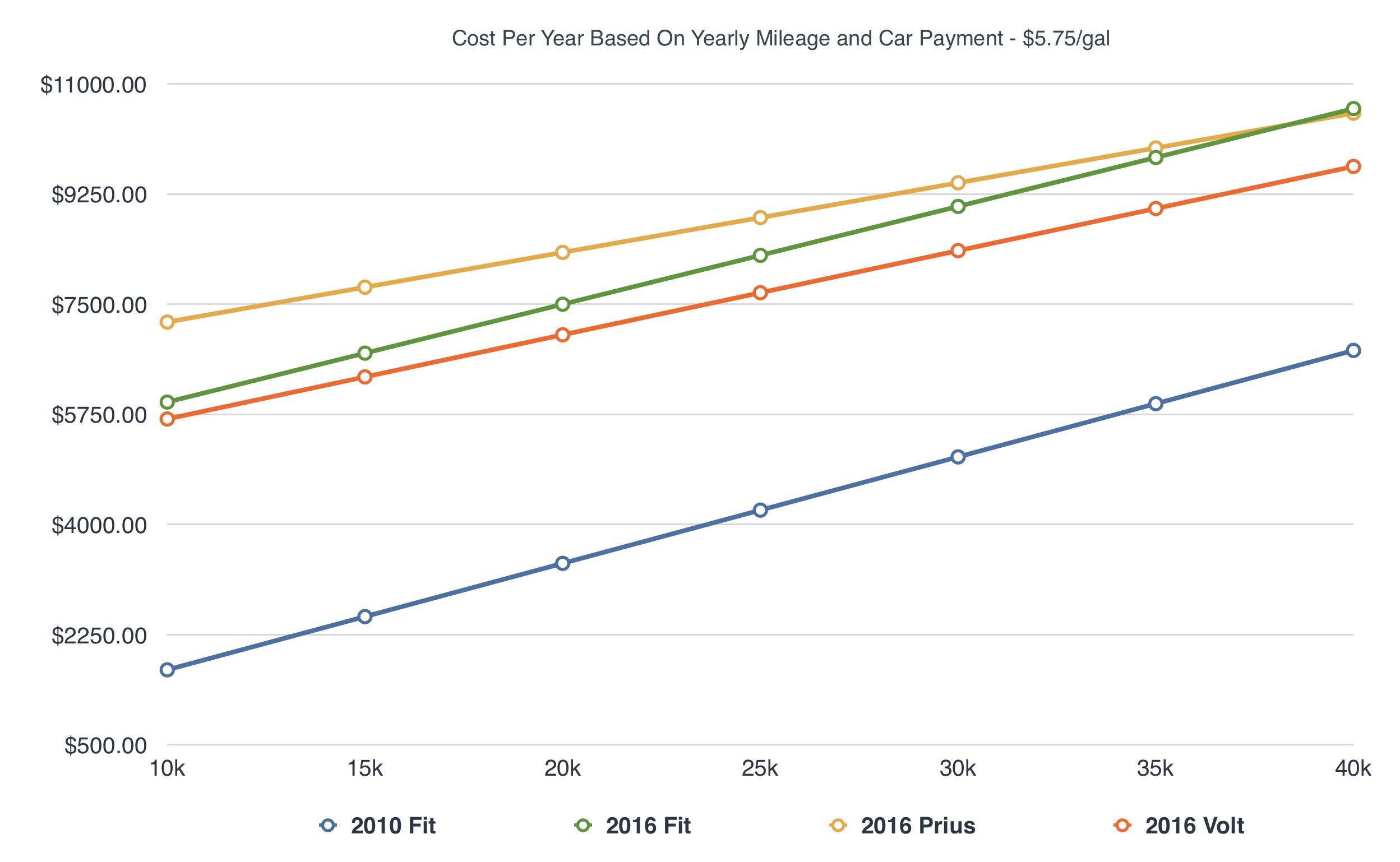
For the Prius to reach a point at which it was comparable or better for every mileage point on the graph I had to ramp the cost per gallon up to $20.00:
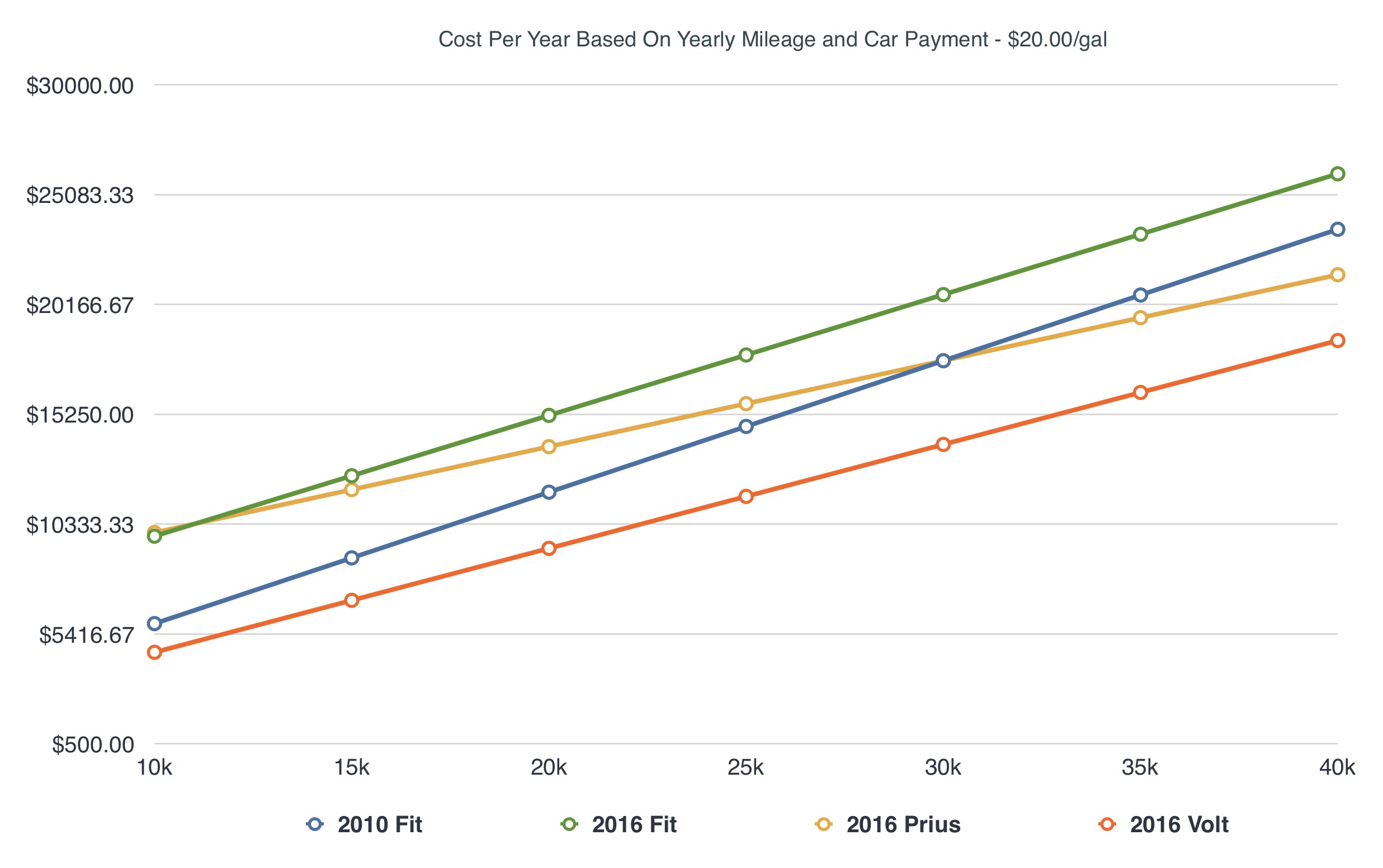
And, at this (hopefully) unbelievable cost level, buying a new Volt is actually a better deal than keeping your old economy car, regardless of how many miles you drive per year. Or it would be, except that it seems likely that, were gas to reach $20.00 per gallon, we'd be cruising the wastelands in Police Interceptors, heavily modified dune buggies, or gyrocopters searching for food and a bit of juice... But I digress...
The larger point to this last bit of fiddling with numbers, I suppose, is that the Volt becomes the most economical new car choice in this mix at a fuel price not that far above prices we've seen in the past decade. This suggests that, from an economical standpoint, General Motors appears to be, at this point, far ahead of Toyota in terms of having a realistic financial savings based upon fuel economy.
Perhaps the only remaining caveat here is that the Volt's purchase price continues to include a federal tax subsidy, and things would be somewhat different - the Volt loses its cost advantage over the Prius under those circumstances. But the current reality is that the tax break is in effect, so it remains a part of the calculation here. And, given the progress GM has made on all fronts with this car, and its ongoing work on the electric side with the upcoming Bolt as well, it doesn't seem too optimistic to believe that they will reach a point of unsubsidized price parity with Toyota in the not-too distant future. This all leaves me far more excited about American - and specifically GM - vehicles than I have been in a very long time.





